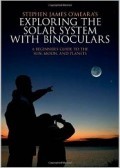 Following on from yesterday’s summer book review, we go from inner space to outer space: Exploring the Solar System with Binoculars: A Beginner’s Guide to the Sun, Moon, and Planets by Stephen James O’Meara. Stephen James O’Meara shows you how to observe our Solar System’s wonders with ease, using nothing more than the unaided eye and inexpensive handheld binoculars. The guide presents a new way to identify and appreciate the wonders of the Solar System in detail, such as lunar and solar eclipses, sunspots, the Moon’s craters, the planets, meteors, and comets. Buy it on Amazon
Following on from yesterday’s summer book review, we go from inner space to outer space: Exploring the Solar System with Binoculars: A Beginner’s Guide to the Sun, Moon, and Planets by Stephen James O’Meara. Stephen James O’Meara shows you how to observe our Solar System’s wonders with ease, using nothing more than the unaided eye and inexpensive handheld binoculars. The guide presents a new way to identify and appreciate the wonders of the Solar System in detail, such as lunar and solar eclipses, sunspots, the Moon’s craters, the planets, meteors, and comets. Buy it on Amazon
A Question and Answer Guide to Astronomy, Bely Pierre-Yves, Christian Carol, Roy Jean-René. This book answers the fascinating questions that we have been asking ourselves for hundreds of years. Using non-technical language, the authors summarize current astronomical knowledge, taking care to include the important underlying scientific principles. Buy it on Amazon
Findings on Elasticity by Pars Foundation, Hester Aardse, and Astrid Baale. What happens when one gives a simple rubber band to an architect, historian, choreographer, chemist, artist, mathematician, physicist, economist, anthropologist, and geologist and asks each of them for a statement on elasticity? Buy it on Amazon
From gorillas, space, and elasticity to risk: How Risky Is It, Really?: Why Our Fears Don’t Always Match the Facts by David Ropeik. The author takes an in-depth look at our perceptions of risk and explains the hidden factors that make us unnecessarily afraid of relatively small threats and not afraid enough of some really big ones. Buy it on Amazon
Finally, the pyramids. The Great Pyramid Secret: Egypt’s Amazing Lost Mystery Science Returns by Margaret. The Great Pyramid Secret delves into the unsolved mysteries of ancient Egyptian engineering and presents many new and intriguing surprises but avoids the traps of sensationalism and dumbing down. It posits an alternative viewpoint that thankfully precludes the need for space aliens, Atlanteans, winged Egyptians or any other such popularist nonsense, to account for the outstanding engineering solutions found by the ancient Egyptians.
So, what is Morris’ answer? With several pieces of evidence and more than a nod to Davidovits, Morris suggests that the Egyptians made artificial rock that when mixed with aggregates, ‘forms concrete that has fooled geologists’ and that the stones of the pyramids were made from blocks produced on site.
The truly fascinating thing about books like this is that they’re truly incredible and no one can prove otherwise so that authors must repeat their message year in year out, perhaps with a string of books in the hope that someone will listen and their theory be accepted. It is, however, quite rare that paradigm shifts in thinking occur (even Einstein was no revolutionary, he simply spotted something that emerges from nineteenth century science and looks obvious in retrospect) and I suspect that we will not be rebuilding our ideas about the pyramids any time soon, despite this publication. Buy it on Amazon
Late addition – The Dark Matter Problem – by Robert H Sanders: Most astronomers and physicists now believe that the matter content of the Universe is dominated by dark matter: hypothetical particles which interact with normal matter primarily through the force of gravity. Though invisible to current direct detection methods, dark matter can explain a variety of astronomical observations. Sanders comments on the sociology of these developments, demonstrating how and why scientists work and interact.